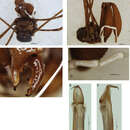Description
provided by Zookeys
Male: Total body length 3.55–4.03 (former measurement refers to 2004 specimen), prosoma length 1.62–2.06, prosoma width 2.55–3.70. Dorsal prosomal plate medium brown, with some yellowish patches laterally; anterior propeltidium and ocularium heavily denticulate, remainder of prosoma unarmed. Dorsum of opisthosoma dark purplish brown with few white spots medially in one specimen, longitudinal purple medial stripe in other; larger white spots in present in central part of opisthosomal dorsum, comparable to lateral ‘arms’ of median stripe in females of other Pantopsalis species. Coxae medium brown mottled with honey brown; venter of opisthosoma medium purplish brown mottled with lighter purple.
Chelicerae: Segment I 4.73–6.23, segment II 6.36–8.47. Segment I medium brown with cream patches at distal end; segment II orange-brown; both segments heavily denticulate. Segment II inflated in larger specimen, slender in smaller. Cheliceral fingers (Fig. 4c) short, mobile finger crescent-shaped.
Pedipalps: Femur 1.81–2.32, patella 0.97–1.15, tibia 1.01–1.18, tarsus 2.10–3.02. Femur light purple at base, remainder of pedipalp shining white. Patella and tibia (Fig. 4d) prolaterally hypersetose, patella bulging prodistally but without distinct apophysis. Microtrichia on distalmost end of tarsus only. Tarsal claw with single ventral tooth.
Legs: Leg I femur 7.91–8.56, patella 1.36–1.58, tibia 6.03–6.14; leg II femur 13.25–13.69, patella 1.82–1.80, tibia 11.18–11.47; leg III femur 6.91–7.38, patella 1.32–1.45, tibia 5.22–5.48; leg IV femur 9.88–10.81, patella 1.57–1.59, tibia7.53–7.38. Femora evenly but irregularly denticulate, except distal third of femur II unarmed; remaining segments unarmed. Legs medium brown mottled with yellowish, tibiae and tarsi tinged with purple, tibiae spotted with white; tarsi with white band at base of telotarsi. Tibia II with five pseudosegments; tibia IV undivided in larger specimen, with two pseudosegments in smaller.
Penis (Fig. 4e–f): Glans medium length, sides parabolic in ventral view; subtriangular in lateral view but not markedly flattened, slight dorsomedial bulge but keel essentially absent. Bristle groups short. Tendon long.
- license
- cc-by-3.0
- copyright
- Christopher K. Taylor
- bibliographic citation
- Taylor C (2013) Further notes on New Zealand Enantiobuninae (Opiliones, Neopilionidae), with the description of a new genus and two new species ZooKeys 263: 59–73
- author
- Christopher K. Taylor

